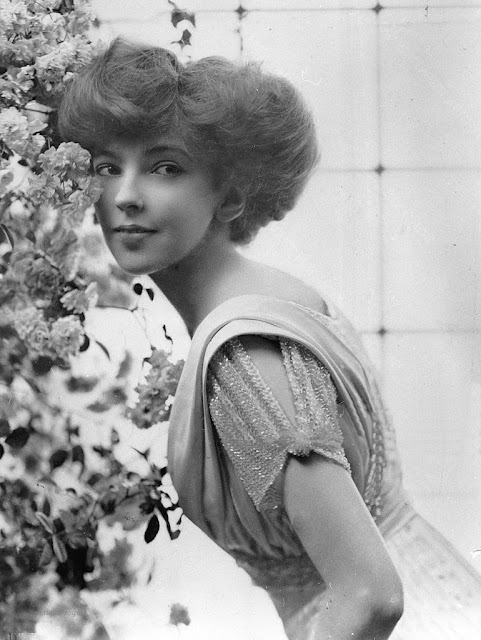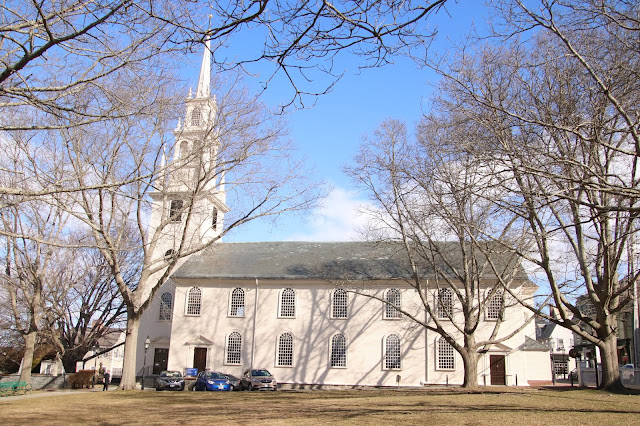 |
| Anita Stewart |
Although he had an impressive lineage, Prince Miguel de Braganca would not have been described as a typical candidate to marry an American heiress. Not only was he perpetually short of funds, but he was also a prince without a country. Miguel was banned from entering Portugal because in 1826, his grandfather, King Miguel I, had usurped the throne from his young niece Queen Maria II. The child queen succeeded to the throne after the death of her grandfather, Joao V, and the renunciation of her father Pedro, the Emperor of Brazil. The condition for his renouncement was for Miguel to marry his daughter. But Miguel, whose kingly ambitions were encouraged by his mother, was not content to be a Regent or King Consort.
For six years, Portugal plunged into a Civil War more deadly than Spain's Carlist wars. With the support of his adoring and domineering mother, Queen Carlotta Joaquina, the army, and nobility King Miguel ruled as an absolute monarch. In 1831 many lives were lost when the king crushed two liberal uprisings. In Brazil, opposition to Dom Pedro‘s rule brought about his application in favor of his son Pedro. The former Emperor returned to Europe in a quest that would end with restoring Maria’s rights in September 1832. Dom Miguel continued to fight for the next two years but peace was finally achieved in May 1834 when Miguel agreed to live in exile. Not only was Miguel required to renounce all rights to the throne for himself and his descendants. he and his heirs were also barred from entering Portugal.
The former king settled in Germany where in 1851 he married Princess Adelheid of Löwenstein-Wertheim- Rosenberg. The couple had one son, Miguel, Duke of Braganza, and six daughters whose marriages with members of the Bavarian Austrian Parma and Luxembourg royal families brought the exiled Braganzas into closer contact with most of Europe’s royal families. The eldest daughter Maria das Neves married the Duke of San Jaime the car list for tender to the Spanish throne.
The Duke of Braganza married twice. He had two sons, Miguel, and Francisco José, and a daughter Maria Teresa by his first wife, Princess Elisabeth of Thurn und Taxis, a niece of Empress Elisabeth of Austria. Princess Elisabeth died several weeks after giving birth to their daughter. The Duke of Braganza waited eleven years before he married again. His second wife was a first cousin, Princess Maria Theresa of Lowenstein-Wertheim-Rosenberg by whom he had eight more children.
For many years the family had lived at Schloss Bronnbach in Baden, Germany. In the 1860s the duke bought Schloss Seebenstein, near Vienna, with money provided by the Dowager Duchess of Braganza's family. By 1909, the Seebenstein estate was heavily mortgaged.
In 1908 the Duke of Braganza began to campaign actively for the restoration of his family's dynastic rights. He was interviewed by several Viennese papers.
Die Zeit and
Die Neue Frei Presse, in which he criticized King Carlos' reign, and he declared himself ready to accept "the throne of his father's".
The duke was supported by his eldest sons. All three were commissioned officers in the Austrian army. the Duke of the Duke was a colonel of the Hussars. Following the murders of King Carlos and Crown Prince Luiz Filipe that October, King Edward VII wrote to Franz Josef expressing his displeasure "that the emperor should allow a Portuguese revolution to be conducted from his capital."
It was intimated that the duke's own statements partially influenced the tragedy in Lisbon. Franz Joseph had allowed the exiled Braganzas to live in Austria. The family was also closely related to his sister-in-law, Archduchess Maria Theresa, the wife of Archduke Karl Ludwig, who was the Duke of Braganca's sister. Although the Duke was allowed to resign his commission his two sons were summarily dismissed from their posts. Francisco José went to live in Paris, while Prince Miguel "spent much of his time on the fringe of London society looking for an heiress," according to
The New York Times.
Several young American heiresses collectively known as the dollar princesses had secured titled husbands among the nobility of Britain and Continental Europe, although, despite the infusion of hard American cash into the genealogically superior but cash-poor families of Europe, the marriages were far from being fairytale events. By the early 1900s, a second generation of the dollar princesses was spending the seasons in London and Paris where they or at least their mamas hope to catch the eye of a very eligible (but not always wealthy) titled me. These young women were attractive educated but naïve and this naïveté appealed to so many young British and European aristocrats. Of course, Daddy's healthy bank balance -- and the promise of a huge dowry, did not hurt their chances to secure a titled husband.
Anita Rhinelander Stewart was one of those women. She was born August 7, 1886, in Elberon, New Jersey 1886. She was one of two children of William Rhinelander Stewart and Annie McKee Armstrong. Anita descended from several of the most prominent New York Knickerbocker families. Her mother “one of the most beautiful and admired" women in New York, was one of the city's great hostesses and it was her attention to the social calendar that led to the couple's divorce in 1906. A lawyer by profession William Rhinelander Stewart was actively involved in many philanthropic matters but was described as a "retiring man" averse to “society rather than courting it; contented with activities which do not create much noise in the world and deriving calm satisfaction from his studies and his books."
Enter James "Silent" Smith, a Wall Street financier, a taciturn man who was a member of a social coterie that was centered in Bar Harbor, Maine, and Tuxedo, New York. Mr. and Mrs. William Rhinelander Stewart were among his closest friends. Some years before Smith had inherited more than $30 million from an eccentric uncle who one afternoon fell asleep in the chair at his London club and did not wake up for dinner.
Friends wondered what James planned to do with his new fortune. He built a great house in Tuxedo, took a parterre box at the opera, leased a townhouse on 57th Street in New York City, and became a patron of the arts. In 1904, he bought the late William C. Whitney‘s magnificent New York townhouse. Society mavens wondered who would become the mistress of his home. Not Mrs. Stuyvesant Fish II, who was his social mentor in Tuxedo, but Mrs. William Rhinelander Stewart who had conducted a “sentimental friendship" with Smith for some years while her own marriage was foundering.
'William Rhinelander Stewart, preferred his charities and municipal reform, while Annie loved parties, the exposure, and the highlights of New York society.
The Stewarts were divorced in August 1906. Less than a month later Mrs. Stewart accompanied by her daughter Anita arrived in England on the
Baltic. On September 13, 1906, Mrs. Stewart and Mr. Smith were married in a parish church in Inverness. The couple said out on a world tour and warn Kobe, Japan, when Smith who suffered from Brights Disease and a heart ailment, collapsed, and died on March 27, 1907. The bulk of Smith’s estate was left to two nephews, but his widow received more than $3 million. Anita was also provided for Smith to leave her $500,000 in life interest in Chicago railroad stock and other ventures.
Encouraged by her socially prominent mother Anita become one of the most eligible of the young American heiresses. It was not a surprise that her fortune would come to the attention of Dom Miguel. In London and in Paris the prince had courted several young American girls. Naturally, he was the subject of much gossip. It was averred that he had pursued Miss Beatrice Mills, but she married the count of Granard instead.
Prince Miguel was first introduced to Anita Stewart in Paris in April 1909 where he "was at once attracted by her." It was an assiduous courtship as Dom Miguel pursued Anita to London where mutual friends arranged for the couple to see each other as often as possible. Their engagement was announced on July 9, 1909, at a concert dance hosted by Anita’s mother. Mrs. Smith had rented the Duchess of Somerset's Berkeley Square house for the season.
The New York Times noted that a “noticeable number of Austrians were among the guests and the entertainment was a very smart affair." Mrs. Smith received her guests in black and wearing a superb string of pearls. Miss Stewart wore a "shimmering gown of pink chiffon over a cloth of silver."
From his summer home in Bar Harbor, William Rhinelander Stewart told reporters he had no comment to make on his daughter's marriage Anita Rhinelander Stewart's "dowry was $1,000,000, which Smith had given to her after his marriage to her mother. Mrs. Smith added another million dollars to the dowry.
Dom Miguel's dynastic claims may have been a bit shaky but so were the questions concerning his marriage to an American. It was erroneously reported that to obtain his father's consent for the marriage Miguel had renounced his right to the Portuguese throne. Anita, however, was not going to settle for a morganatic marriage. She made it quite clear that she would not marry Miguel if the marriage had been designated as unequal. The wealthy Miss Stewart also caught the eye of Emperor Franz Joseph. On September 6, it was announced that the Austrian emperor conferred on Miss Stewart the rank of Princess in her own right.
"It seems rather easier than we thought for an emperor to transform a plain American miss into a Princess when no principality goes with the title and no pecuniary endowment. Miss Stewart is buying her own principality, and is expected to endow rather than being endowed,
" commented the New York Times in one editorial.
The reports about Anita being created a Princess in her own right were incorrect. Franz Josef did nothing of the sort. What he did, however, was to recognize her status "as determined by Portuguese rules of nobility."
Indeed, the forthcoming nuptials of the American heiress and the bankrupt Portuguese Prince were preceded by “an avalanche of breathless speculation by the New York newspapers" on the couple's chances of one day reigning in Portugal. At the time of their marriage, King Manoel II was unmarried as was his heir presumptive his uncle, the Duke of Oporto.
Several days before the wedding, Miguel gave a luncheon party at Claridge's Hotel for his bride-to-be.
The Times regaled its readers with the report “that elaborate preparations are being made in Dingwall for the wedding” and that Miss Stewart was staying at Tulloch Castle, which her mother had rented for the duration of the shooting season. “The church is to be converted into a grotto buying arrangement of evergreens and smilax, the sanctuary will be decorated with palms and white lilies and the front of the choir will be decorated with the Braganca colors, ruby, and blue."
The wedding was nearly canceled because Anita refused to convert to Roman Catholicism. The matter was quietly settled on the eve of the marriage with Mrs. Smith agreeing to pay Miguel's massive debts.
The 31-year-old bridegroom’s gift to his bride was a feather cluster of diamonds and sapphires that belong to the Portuguese royal family for more than 200 years. King Miguel had presented the jewels to his daughter-in-law Princess Elisabeth of Thurn und Taxis when she married the Duke of Braganza. Dom Miguel inherited her jewels. The Duke of Braganza's sister-in-law, Archduchess Maria Theresa (the widow of Archduke Karl Ludwig) gave the bride 5
écaile blonde combs; another of Miguel's aunts, the Princess of Schwartzenberg gave a parasol. Mrs. Smith’s gift to her daughter was a diamond tiara and a row of pearls. Anita presented her husband with a gold watch set in diamonds, a gold chain, and a gold locket also set in diamonds.
The wedding took place on September 15, 1909, at St. Lawrence Roman Catholic Church in Dingwall. The
New York Times noted that this was the first royal wedding in Scotland since Mary Queen of Scots. Coincidences abounded: both marriages have been performed by Bishop Chisholm; the bride descended from the Stewart kings as did Prince Miguel, and the congregation of the little church was made up of descendants of those clans who were Catholic during the reign of Mary Queen of Scots. The roads that lead from Tulloch Castle to the little church were decorated with American, Austrian, and Portuguese flags. Anita would have noticed a sign that read “Long life and happiness to the prince and princess" as she was driven to the church.
[Anita Stewart was a descendant of King James I of Scotland by his wife Joan Beaufort, a granddaughter of John of Gaunt and Katherine Swynford. The details of the line of the descent can be found in
Americans of Royal Descent: A Collection of Genealogies of American Families Whose Lineage is Traced to the Legitimate Issue of Kings by Charles Henry Browning, which was published in 1891.
https://books.google.com/books?id=dIUaAAAAYAAJ&pg=PA404&lpg=PA404&dq=lispenard+stewart&source=bl&ots=0k2SALr7Wv&sig=ACfU3U3AKUtFAwczbJx6WbeZ8jpnvuoKUQ&hl=en&sa=X&ved=2ahUKEwj2yfLR663hAhVPL6wKHYgQDjkQ6AEwDXoECAkQAQ#v=onepage&q=lispenard%20stewart&f=false]
The ceremony began at noon. To the strains of "the Wedding March" from Wagner's opera
Lohengrin, the bride was escorted down the aisle by her tartan-clad brother William Rhinelander Stewart, Jr. There were no attendants. Anita "wore a graceful dress, carrying a long train of snow-white chiffon over soft satin. The chiffon was embellished by long lines of fine embroidery in white silk heather and tiny pearls, made up of sprays of heather, Fleur de Lis, and Portuguese devices." Her veil was of old lace worn over a wreath of orange blossoms and heather and held in place by the feather clusters given to her by Prince Miguel. The bride also wore a set of combs, a gift from Archduchess Maria Teresa.
Attired in a Maltese uniform, “a brilliant scarlet Court dress, heavily decorated with gold, Miguel was supported by his younger brother Prince Francisco José. The wedding ceremony lasted 20 minutes and was followed by a Low Mass. Bishop Chisholm, who said mass daily for the king and queen of Spain, when they visited Scotland, pronounced the Pope‘s blessing for the couple.
The newlyweds and their guests return to Tulloch castle for the wedding breakfast. The new Duke and Duchess of Viseu as they were now officially styled, were driven to Inverness where they caught the train for the south. They traveled to Vienna where Emperor Franz Josef presented the new princess to the Austrian Court.
Miguel and Anita lived with her mother in London until she got tired of supporting Miguel's spendthrift ways. In June 1910 Anita gave birth to a daughter, Nada. Two years later at Pippingford in Sussex, the couple's first son John was born. The outbreak of World War I forced the family, who were Austrian nationals, to seek refuge in Switzerland. Their third child Miguel was born in Berlin in September 1915.
Miguel abandoned his family to join the German army. Anita and the three children remained in Switzerland until December 1919 when they sailed to New York on the Italian liner,
Pesario. The family was met at the pier by William Rhinelander Smith who had not seen his daughter in 11 years and her brother, William. The three little Braganza children all wore sailor costumes with pilot coats and brass buttons, Seven-year-old Prince John told reporters: “Yes, we had Christmas on board but there were not many gifts." Anita said she planned to remain in America indefinitely but added that her husband would stay in Switzerland due to his status as an “ex-territorial" Her brother denied that his sister and her husband were estranged, adding that “they were very much attached to each other."
Eventually, Prince Miguel, who had trained as a broker in London before the war, was reunited with his wife and children in New York. In November 1922, he started work as a salesman with John C. Paige & Co, an insurance firm where his brother-in-law was a member. Returning to Europe to live was out of the question. Austria was now a republic and its royal family -- Miguel's cousins --were in exile.
A revolution in 1910 ended the Portuguese monarchy. King Manoel II was living in England with his wife, Princess Augusta Victoria of Hohenzollern, whom he had married in 1913. The couple had no children. In 1917, the Duke of Oporto married an American woman, Nevada Hayes. This marriage was also childless. If the Portuguese throne were to be restored, the Duke of Braganza's descendants could return to Portugal. In July 1920, the Duke of Viseu waived all rights for himself and his descendants to the putative Portuguese throne. A week later his elderly father renounced his rights in favor of his third son Dom Duarte.
King Manoel II had never given his approval for marriage. By the late 1920s, after the deaths of Prince Miguel and his father, the status of Anita and her children changed. This was noted in the Almanach de Gotha. Until the volume was published in 1927, Anita's three children were listed with their full names and titles. But after 1927, the Gotha included the marriage but not the details about the children, apart from the fact that the couple had two sons and one daughter. The reason for this change was due to the relationship between King Manoel II and Dom Duarte, who was the younger half-brother of Prince Miguel. He succeeded as Duke of Braganza on October 11, 1927, following the death of his father. The plans were in place for the new Duke, then only 20 years old, to be recognized as Manoel II's heir.
Anita's descendants have no dynastic rights to the Portuguese throne.
[After King Manoel II died in 1932, Dom Duarte's rights were assured when Portuguese monarchists acknowledged him as King Duarte I. In 1950, Portugal’s National Assembly lifted the ban against the descendants of King Miguel. The current head of the house is Dom Duarte's eldest son Duarte, Duke of Braganza, who lives in Lisbon with his wife and two children.]
In February 1923, Anita and Miguel were staying at her brother's New York residence when Miguel suffered a severe attack of influenza. As Miguel was responding to treatment, Anita left for Newport, Rhode Island, to visit their summer home, the Moorings. His condition quickly worsened when he developed double pneumonia and Anita was summarily recalled from Newport.
One of his childhood friends, Count Laszlo Széchényi Sárvár-Felsövidék,, who was Hungary's Minister to the United States, came from Washington, D.C., to see him. Anita's brother hurried back from his winter home in Palm Beach, Florida. All three were at Miguel's bedside when he died at 2:00 a.m., on February 21. Funeral services were held at the Stewart home. A High Mass was solemnized at the church of Saint Vincent Ferraro and, at his expressed wish Miguel was buried at Bronnbach in Baden,
Anita's mother, Annie, who had married for a third time in 1915 to Jean St. Cyr, died in California in 1925. She left an estate worth $40 million, of which one-third was left to her younger husband. Nearly $250,000 of the estate was given to Prince Alexander of Thurn und Taxis, a cousin of Prince Miguel. The money he received represented a share of securities valued at $500,00, that the then Mrs. Smith had turned it over to the Girard Trust Company in 1913. Alexander received a share of this trust as Miguel had been indebted to his cousin for the sum of $55,936. At that time, Anita assigned to Prince Alexander an interest "amounting to about $240,000, effective upon Mrs. St. Cyr's death." She had made the assignment to pay her husband's cousin after her mother's death. By accepting the assignment, Alexander released Miguel from "all liability on the judgments."
Anita inherited the rest of her mother's estate. She regained her American citizenship in March 1926 following the renouncement of her royal titles in the Superior Court in Newport. Although her legal name became Anita de Braganca, she was still referred to as Princess Anita, especially socially. Several years later, in an action that surprised many in her social circle, Anita opened a photography studio in New York City which she operated for many years.
Her father died in September 1929. Anita and her brother were heirs to their father's estate and also received a percentage of the residue and two trusts from their father's older brother, Lispenard Stewart, who had died in 1927.
She maintained contact with her husband's family in Europe. In 1934, Anita made the official announcement of her half-sister-in-law, Princess Maria Antonia's engagement to Harvard graduate Ashley Chandler.
Maria Antonia had come to the United States in the summer of 1933 to be a bridesmaid at the marriage of Agnes Clark in San Mateo California. She enjoyed her visit to the States so much that she remained with friends in Bar Harbor. She also spent time with Anita and her family at their home in Newport. Ashley Chanler, a descendant of John Jacob Astor had met his future wife on board the Europa. They married on June 14, 1934, at Schloss Seebenstein, but resided in New York City.
On April 10, 1946, Anita, who was described by the New York Times as Princess de Braganca, married Lewis Gouverneur Morris, at St. Ann's Episcopal Church in the Bronx. Morris. a "member of a family long identified with society here (NYC) and in Newport, was a descendant of several colonial American families. He was a former banker, who had served time in prison in 1921 after his brokerage firm had suffered a financial failure. His first wife, Nathalie Lorillard Bailey, died in 1935.
The newlyweds divided their time between Malbone Castle in Newport and a residence at 1510 Park Avenue in New York City.
The joy of her marriage was soon tempered by the death of her only daughter, Nada, who had been married twice, and committed suicide, leaving behind a teenage son. John and Miguel became American citizens. John settled in Winston Salem North Carolina and Miguel, an airline pilot, raised his family in Bedford Hills New York. The two brothers and their families also maintained winter homes in Palm Beach, Florida. John died in 1991 and Miguel passed away at his home in Palm Beach in February 1996.
 |
| Malbone Castle |
Lewis Morris died at Malbone Castle after a lengthy illness.
Anita spent her final years at her homes in Newport and Palm Beach. She died on September 15, 1977, the 66th anniversary of her first marriage, at Malbone Castle in Newport.
Anita and Lewis are buried next to each other in the cemetery at St. Columba Episcopal Church in Middletown, Rhode Island.
[Anita was not the only member of her family to marry into foreign nobility and royalty. Her maternal first cousin, Margaretta Armstrong Drexel, the daughter of Alexander Drexel of Philadelphia and Margarita Armstrong, married Guy Finch-Hatton,14th Earl of Winchilsea and 9th Earl of Nottingham, in 1910. Their eldest son, Christopher, the 15th Earl of Winchilsea, married Countess Gladys Széchényi Sárvár-Felsövidék, the 3rd of five daughters of Count Laszlo Széchényi Sárvár-Felsövidék and Gladys Vanderbilt. Laszlo was the childhood friend of Prince Miguel.]
An earlier version of this article was published in 1996 in
Royalty Digest.
If you enjoyed this article














































































